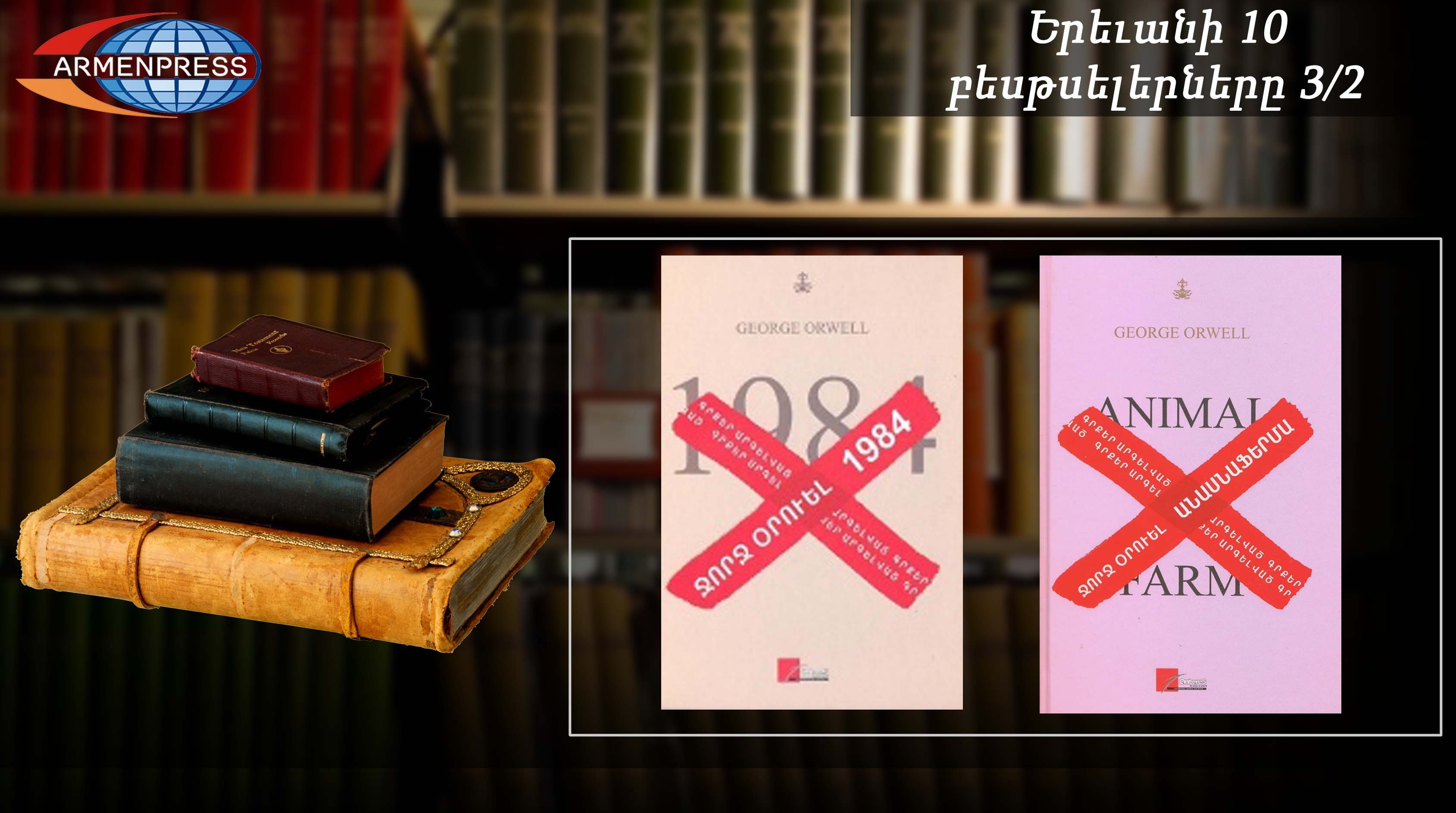"Armenpress" introduces bestseller books list 3/2
 09:45, 6 March 2015
09:45, 6 March 2015YEREVAN, MARCH 6, ARMENPRESS. "The Little Prince" by French author Antoine de Saint-Exupéry tops this week's "Bestseller Books List" introduced by "Armenpress" News Agency. The novella is both the most read and most translated book in the French language, and was voted the best book of the 20th century in France. The book was translated into more than 250 languages and dialects, as well as Braille.
Saint-Exupéry, a laureate of several of France's highest literary awards and a reserve military pilot at the start of the Second World War, wrote and illustrated the manuscript while exiled in the United States after the Fall of France. He had travelled there on a personal mission to persuade its government to quickly enter the war against Nazi Germany. In the midst of personal upheavals and failing health he produced almost half of the writings he would be remembered for, including a tender tale of loneliness, friendship, love and loss, in the form of a young prince fallen to Earth.
The book titled “Mandylion” by experienced lawmaker and mature statesman Vahan Hovhannisyan, of holy memory, occupies the second place of this week's "Bestseller Books List">
"1984" by George Orwell occupies the third position of the Bestseller Books List introduced by "Armenpress" News Agency. While 1984 has come and gone, Orwell's narrative is more timely that ever. 1984 presents a "negative utopia", that is at once a startling and haunting vision of the world — so powerful that it's completely convincing from start to finish. No one can deny the power of this novel, its hold on the imaginations of entire generations of readers, or the resiliency of its admonitions — a legacy that seems to grow, not lessen, with the passage of time.
“Sulamith: the Great love of Sevak” by Hovik Charkhchyan occupies the fourth place. Sevak is considered one of the greatest Armenian poets of the 20th century. Sevak was born Paruyr Ghazaryan in Chanakhchi (now Zangakatun) village, to Rafael and Anahit Soghomonyan on January 24, 1924. Young Paruyr attended the village school and later in 1940 moved to Yerevan to study at the philological faculty of Yerevan State University. He graduated from the YSU in 1945. The same year he starts a postgraduate study of Armenian literature at the Academy of Sciences Abeghyan Institute of Literature. In 1951 Sevak went to Moscow to study at the Gorky Institute of World Literature. Graduating from that institute Paruyr works there in 1957-59 as a translating professor.
"The Little Prince" by French author Antoine de Saint-Exupéry, published by Edit Print publishing house, occupies the fifth place.
“Who Moved My Cheese?” by Dr. Spencer Johnson occupies the sixth place. With Who Moved My Cheese? Dr. Spencer Johnson realizes the need for finding the language and tools to deal with change--an issue that makes all of us nervous and uncomfortable.
Most people are fearful of change because they don't believe they have any control over how or when it happens to them. Since change happens either to the individual or by the individual, Spencer Johnson shows us that what matters most is the attitude we have about change.
When the Y2K panic gripped the corporate realm before the new millenium, most work environments finally recognized the urgent need to get their computers and other business systems up to speed and able to deal with unprecedented change. And businesses realized that this was not enough: they needed to help people get ready, too.
Spencer Johnson has created his new book to do just that. The coauthor of the multimillion bestseller The One Minute Manager has written a deceptively simple story with a dramatically important message that can radically alter the way we cope with change. Who Moved My Cheese? allows for common themes to become topics for discussion and individual interpretation.
Who Moved My Cheese? takes the fear and anxiety out of managing the future and shows people a simple way to successfully deal with the changing times, providing them with a method for moving ahead with their work and lives safely and effectively.
"Animal Farm" by George Orwell occupies the seventh position of our list. Animal Farm is an allegorical and dystopian novel, published in Englandon 17 August 1945. According to Orwell, the book reflects events leading up to theRussian Revolution of 1917 and then on into the Stalin era in the Soviet Union. Orwell, ademocratic socialist, was an outspoken critic of Joseph Stalin and, especially after experiences with the NKVD and the Spanish Civil War, he was actively opposed to the controversial ideology of Stalinism. The Soviet Union, he believed, had become a brutaldictatorship, built upon a cult of personality and enforced by a reign of terror. In a letter to Yvonne Davet, Orwell described Animal Farm as a satirical tale against Stalin "un conte satirique contre Staline", and in his essay "Why I Write" (1946), he wrote that Animal Farm was the first book in which he had tried, with full consciousness of what he was doing, "to fuse political purpose and artistic purpose into one whole".
The original title was Animal Farm: A Fairy Story, though the subtitle was dropped by U.S. publishers for its 1946 publication and subsequently all but one of the translations during Orwell's lifetime omitted it. Other variations in the title include: A Satire and A Contemporary Satire. Orwell suggested the title Union des républiques socialistes animales for the French translation, which recalled the French name of the Soviet Union,Union des républiques socialistes soviétiques, and which abbreviates to URSA, the Latinfor "bear", a symbol of Russia.
And "The Name of the Rose" by Italian author Umberto Eco occupies the eighth place of this week's "Bestseller Books List" introduced by "Armenpress" News Agency. A spectacular best seller and now a classic, The Name of the Rose catapulted Umberto Eco, an Italian professor of semiotics turned novelist, to international prominence. An erudite murder mystery set in a fourteenth-century monastery, it is not only a gripping story but also a brilliant exploration of medieval philosophy, history, theology, and logic.
In 1327, Brother William of Baskerville is sent to investigate a wealthy Italian abbey whose monks are suspected of heresy. When his mission is overshadowed by seven bizarre deaths patterned on the book of Revelation, Brother William turns detective, following the trail of a conspiracy that brings him face-to-face with the abbey’s labyrinthine secrets, the subversive effects of laughter, and the medieval Inquisition. Caught in a power struggle between the emperor he serves and the pope who rules the Church, Brother William comes to see that what is at stake is larger than any mere political dispute–that his investigation is being blocked by those who fear imagination, curiosity, and the power of ideas.
The Name of the Rose offers the reader not only an ingeniously constructed mystery—complete with secret symbols and coded manuscripts—but also an unparalleled portrait of the medieval world on the brink of profound transformation.
"Love in the Time of Cholera" by Colombian author Gabriel García Márquez comes the ninth. In their youth, Florentino Ariza and Fermina Daza fall passionately in love. When Fermina eventually chooses to marry a wealthy, well-born doctor, Florentino is devastated, but he is a romantic. As he rises in his business career he whiles away the years in 622 affairs--yet he reserves his heart for Fermina. Her husband dies at last, and Florentino purposefully attends the funeral. Fifty years, nine months, and four days after he first declared his love for Fermina, he will do so again.
"One Hundred Years of Solitude" by again Columbian author Gabriel García Márquez occupies the final place. One Hundred Years of Solitude tells the multi-generational story of the Buendía family, whose patriarch, José Arcadio Buendía, founds the town of Macondo, the metaphoric Colombia.
The widely acclaimed book, considered by many to be the author's masterpiece, was first published in Spanish in 1967, and subsequently has been translated into thirty-seven languages and has sold more than 30 million copies. The magical realist style and thematic substance of One Hundred Years of Solitude established it as an important, representative novel of the literary Latin American Boom of the 1960s and 1970s, which wasstylistically influenced by Modernism (European and North American) and the Cuban Vanguardia (Vanguard) literary movement. One Hundred Years of Solitude tells the story of the rise and fall, birth and death of the mythical town of Macondo through the history of the Buendía family. Inventive, amusing, magnetic, sad, and alive with unforgettable men and women -- brimming with truth, compassion, and a lyrical magic that strikes the soul -- this novel is a masterpiece in the art of fiction.
To complete the bestseller list, the following bookshops have participated in the survey: “New Book” (093-60-40-64), “Noah’s Ark” (56-81-84), Armenian Book” (54-07-06), “Edit Print” (57-70-09), “Bureaucrat” (50-01-52), “Bookinist” (53-74-13), “Art Bridge” (58-12-84) and “Zangak” (23-25-28).
Completed by Roza Grigoryan




















